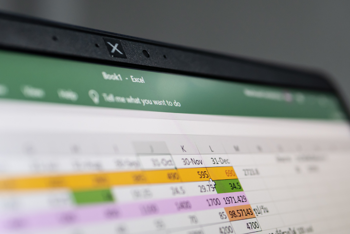What is the best production planning alternative to excel?
Is it time to leave Excel behind? We outline how using Excel for production modelling is holding manufacturers back and why advanced planning and scheduling (APS) software should be part of any manufacturing business with growth ambitions.
The Use Of Excel In Manufacturing Production Planning
The use of Excel spreadsheets for production planning and scheduling in manufacturing is surprisingly widespread. Familiar to many planners, Excel is seen as a quick, easy and low-cost option when it comes to production scheduling.
While Excel has many advantages, the nearly 40-year-old application is showing its constraints as part of a dynamic manufacturing environment, meaning that production planning and scheduling software for manufacturing may be more suitable.
As industry 4.0 dawns and factories grow smarter with the use of cloud and AI-based technologies, there is a growing demand for production to be more flexible and agile in an unpredictable world.

What Is The Alternative To Excel For Production Planning?
Manufacturing is a competitive sector as production must match with demands for more complex products, faster turnaround and delivery and smaller batch sizes.
Advanced Planning and Scheduling (APS) software was developed to help manufacturing environments meet these needs. Created specifically to handle production plans, APS uses capabilities beyond the Excel spreadsheet, including drag & drop Gannt charts, ‘what-if’ analysis, complex scheduling and forecasts to help production lines run efficiently.
Here we outline the disadvantages of planning manufacturing production on Excel.
|
Excel Spreadsheets |
Production Planning Software |
|
Often ‘Legacy’ spreadsheets built by one person |
A single, intuitive system accessed across a planning team |
|
Can take days to build |
Takes a few hours to build a plan |
|
Vulnerable to data errors |
Data input errors flagged automatically |
|
Hard to scale |
Built to scale with business growth |
|
Version control errors can lead to several versions of a single spreadsheet |
A single source of the truth in one system |
|
Can go out-of-date as demands and processes change |
Can be quickly edited to account for changes |
|
No forecasting features |
‘What-if?’ analysis tests different scenarios |
|
No live updates means spreadsheets can lack accuracy |
Real-time data means plan will always be as accurate as possible |
|
No way to visualise planning |
Provides data visualisation |
Disadvantages of Excel For Production Planning
Manufacturing Planning Excel Spreadsheets Are Complex
Excel is extremely versatile, but it production planning was not its original purpose. Because of this, a production plan in Excel can be a very complex document with thousands of rows and complex calculations. Producing and updating the document is time-consuming and open to errors.
Production planning spreadsheets also vary in quality, with many only accounting for critical resources or accounting only for a simple production outline.
Spreadsheets can’t easily take equipment, labour, materials constraints into consideration, and when there are changes, what the effect on these constraints will be.
APS software takes all production resources into account, including capacity limitations, storage levels and dependencies.
Human Errors Happen
Even the most experienced Excel user can make mistakes. In fact, a study from the University of Hawaii predicted that 88% of spreadsheets contain errors. There are many horror stories around spreadsheet errors, the most infamous being JP Morgan making a $6 billion loss in 2012 due to a simple copy/paste error on a spreadsheet.
With the complexity of production planning spreadsheets, small errors can create a domino effect where errors compound and creates further errors in other parts of the plan. The results can be disastrous for manufacturing businesses.

Legacy Spreadsheets Can Cause Headaches For Planners
Many production plan spreadsheets are based on a template that’s been used for years and may no longer be fit for purpose. Businesses change and corresponding systems need to evolve with them. More often than not, a legacy spreadsheet has been the responsibility of a single p-lanner who understands the complexities and quirks of a spreadsheet deeply, but other users may not have a grasp on the creators’ ‘way of doing things’.
There is also a high risk that the creator of a legacy spreadsheet may move on to another company and not hand over their work correctly, risking delays to production and a negative impact on operations.
Spreadsheets Are Time-Consuming
With advanced planning and scheduling software, you can cut planning time down from days or hours to as little as an hour.
Modelling different production scenarios is easy and can be done in a matter of hours – in Excel it could take three or four days.
Production planning software provides one version of the truth, a real-time production plan which includes all tasks, dependencies and constraints. Not only is equipment, labour and materials information part of the planning process, but satellite activities such as preventative maintenance, quality control and buffers and media planning are included also.
Better resource planning delivers greater efficiency from improved equipment and labour utilisation. APS software frees your planners to focus value added work such as identifying issues before they occur: bottlenecks, resource under / over utilisation, what if analysis for example.
Spreadsheets Are Not Intuitive
Complicated spreadsheets tend to be clunky to both look at and use, with little room to make fast and dynamic changes if a plan changes (which they have a habit of doing).
With manufacturing scheduling software, intuitive ‘drag and drop’ functionality allows changes to be made quickly, updating all activities automatically.
Advanced functionality in production scheduling software, including forwards and backwards scheduling, also helps to reduce Work In Progress (WIP). Materials can be scheduled as and when required, reducing stock and improving cashflow.
Spreadsheets Do Not Scale
If a manufacturing business is performing well, it is likely there will be future plans to scale-up, adding new sites, capacity and products to production. Spreadsheets can struggle to scale with a business, having to handle even more data and grow even more complex as more is added. The risk of human error increases the more complex an Excel build grows.
Production planning software is designed to scale as a business grows, and can make scaled-up production far easier and faster.
Excel Can Lead To Poor Communication And Collaboration
Good communication is key to efficient operations. One negative that stands out for Excel is version control. There are no guarantees that everyone is working from the latest version of a production spreadsheet. This could lead to wasted time and resources, miscommunication, and confusion between teams.
One consequence of this would be less-than-smooth changeovers between shifts. Another example, provided by one of our customers, is of engineers turning up for planned maintenance, only to learn that the schedule has changed.
With planning software, you know that everyone is working from one central live plan, visible to the right people at the right time. Updates are shown immediately, and all teams understand what’s required and when, reducing downtime between shifts for batch handover.
Spreadsheets Lack Accuracy
Without the ability to easily take constraints and dependencies into consideration, Excel spreadsheets can only provide a high-level view of production and they don’t reflect reality on the shopfloor.
APS software allows you to produce plans which are accurate to the minute. From a customer communication perspective, it means that you can provide dates and timescales to customers with the confidence that they will be met.
Your customers will be happier regardless – with production planning software, accurate scheduling means shorter lead times based on actual capacity rather than generic lead times.
Spreadsheets Quickly Go Out-Of-Date
Modelling production scenarios in Excel is not only significantly time-consuming but can quickly be out-of-date and inaccurate.
Advanced planning and scheduling software provides an accurate, holistic view of production. What-if analysis can be used to explore new initiatives, for example whether to invest in a new site. Business leaders have the data they need develop plans for the future direction of their business.

Step-Up Your Manufacturing Efficiency With Production Planning Software
At one time, Excel spreadsheets met a need for teams looking to move to electronic production plans. However, technology has evolved significantly over the years and with the fast pace of change in manufacturing and ever complex production processes, a new approach to planning and scheduling is needed. The proven benefits delivered by advanced planning and scheduling systems cannot be ignored any longer.

 AU & NZ
AU & NZ
 SG
SG
 MY
MY
 US
US
 IE
IE







